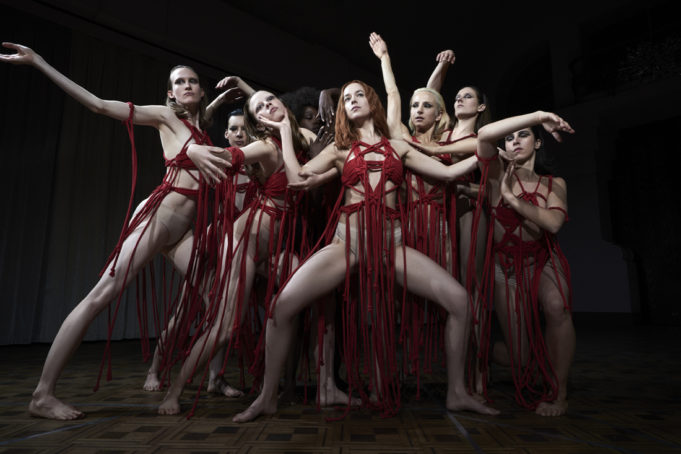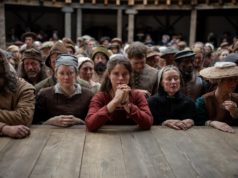First, a confession: I’m not a big fan of Dario Argento’s Suspiria. The production design and the music in the 1977 horror film are awesome, the wooden acting not so much. That said, I couldn’t wait to see the new Suspiria remade by a fellow Italian. Sure enough, Luca Guadagnino has made this bloodfest (which opens this weekend at Alamo Drafthouse Denton and AMC Parks at Arlington) into something intensely beautiful but also more thoughtful and entirely its own.
Like the original, this film is set in Germany in 1977 but more grounded in the politics of the time. The film is subtitled “Six Acts and an Epilogue Set in a Divided Berlin,” and each section is cordoned off by a title card. The plot begins with Susie Bannion (Dakota Johnson), a Mennonite girl from Ohio with no formal dance training but a great passion for the art, arriving there to study at an academy headed by a legendary choreographer (Tilda Swinton). As Susie realizes that her school is a front for a coven of witches, her story connects with an elderly German psychiatrist named Klemperer (Lutz Ebersdorf, a.k.a. Swinton made up to look like an 80-year-old man) investigating the school from the outside after an American patient who’s also a student there (Chloë Grace Moretz) suddenly goes missing after raving to him about witches.
This is quite a second act for Guadagnino — anyone who comes into this expecting something like his gossamer coming-of-age drama Call Me By Your Name will receive a mighty shock. He ditches Argento’s wacky, flamboyantly baroque decor (as I said, my favorite part of the original film) in favor of a drab, brutalist look in a city where it’s always either raining or snowing. The dance academy is still in a grand building, but everything’s covered in a layer of grime. Guadagnino and cinematographer Sayombhu Mukdeeprom make you feel the rising damp in the place, while the score by Thom Yorke and the sounds of whistling and whispering in the hallways generate a rising sense of dread. Nor is there refuge outside, as the streets are constantly filled with angry crowds protesting the Baader-Meinhof gang’s imprisonment. The guiding aesthetic is not Argento but Rainer Werner Fassbinder (who was making his films in Berlin in the 1970s), and it’s entirely appropriate.
The old Suspiria had hardly any dance, a shortcoming that this remake corrects. Choreographer Damien Jalet puts together some striking contemporary numbers, including one called Volk, in which Susie and the company gyrate in red costumes with long tassels that whip around. The climactic bloodbath is structured as another dance number, with naked women thrashing around as unholy vengeance is visited upon the coven. These sequences do more than just inject visual opulence into the proceedings. Guadagnino cuts these sequences to give the dances the power of incantation, such that we believe that they’re rituals to summon ancient evils.
No dance is more striking than the one that Susie does in rehearsal while a Russian dancer named Olga (Elena Fokina) walks into a trap while she’s storming out of the academy. Guadagnino intercuts Susie’s explosive movements with Olga’s death throes so that it looks like Susie is somehow causing the murder with her dance. The result is beautiful, gruesome, and buggy like few other horror films offer. Susie has nightmares of a childhood scarcely less horrific than the place she’s in now, and Guadagnino proves to be as adept as anyone at piecing together montages of unexplained images to unsettling effect. He’s torn between admiration for women’s bodies in motion and horror at those bodies being mutilated, and that tension helps make this a worthy modern-dance successor to Black Swan.
The ending is where this film departs markedly from the original. Susie is still an avenging angel but of a wholly different stripe. Argento referenced World War II and the Holocaust in his movie in coded, oblique ways, but Guadagnino and screenwriter David Kajganich make them more explicit in Klemperer’s story, culminating in an epilogue where Susie pays a visit to the old doctor. I’m not a Dakota Johnson fan either, but the scene features remarkable work from her as the dialogue probes survivor guilt and Germany’s historical guilt. This quiet ending has the power to shake you, and I find it as haunting as any of the splashier scenes here. Suspiria is a nightmare told in great spurts of blood across black canvases and great slashing movements by its dancers.
Starring Dakota Johnson and Tilda Swinton. Directed by Luca Guadagnino. Written by David Kajganich, based on Dario Argento and Daria Nicolodi’s screenplay. Rated R.













I loved this movie.